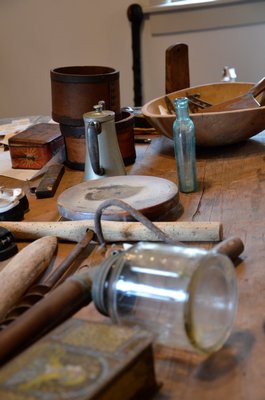
Inside the old Barnes-Lester farmhouse on the corner of Cedar and North Main streets in East Hampton, time seems to rewind.
Well-built dressers, solid tables and chairs, kitchen contraptions like a nutmeg crusher and a gas and wood-burning stove, and precious tchotchkes from near the beginning of the 20th century decorate the abode as if the family living there had just stepped out to attend to their chores.
On Saturday, October 11, from 10 a.m. to 4 p.m., the public will get to experience what life was like on a farm around 1900 at the new East Hampton Farm Museum.
Those who attend the opening can help plant garlic in the museum’s garden, listen to live banjo and fiddle music and enjoy cider and donuts, according to Prudence Carabine, an East Hampton native who has led the effort to create the museum.
It’s thanks to many East Hampton residents and history buffs that the museum is as far along as it is, according to Ms. Carabine. From pewter salt and pepper shakers to an antique writing desk, each item inside the home was donated or loaned by members of the community and the East Hampton Historical Society.
Each piece seems to carry a story along with it. In the farmhouse’s parlor, a love letter from Sineus Conklin Miller Talmage to a Miss May E. Lester hangs on the wall for all to read. A 1875 melodeon sits only a few feet away, and a deep, old chair from Roy Lester begs to be sat in. Ms. Carabine herself donated the chair, which was dubbed the “big ass chair” in the 1950s because it had been made for one of Mr. Lester’s “big ass uncles,” as he used to say.
“We had a lot of Lesters involved in this,” said Ms. Carabine, who is a descendant of the Talmages.
To help tell such stories about what life was like around 1900, the museum committee needs to find at least 50 to 70 volunteer docents who could donate at least one day, since East Hampton Town officials would like the museum to be open at least once a week through midwinter, and with at least two docents per day, Ms. Carabine said.
The museum is also asking for donations of items dating from 1890 to 1920: period clothing, cast-iron cooking pots, children’s toys, feather pillows, serving pieces and a hand pump.
Not only will visitors get to see the tools, machinery and finery that a family may have used in the late 19th century, but they will get to view footage in the media room of old-time Bonackers talking about their families and other farmers and fishermen in East Hampton. Other films are on their way, including one about the history of three wind-powered sawmills that were located on the property in the past.
The house and the barn sit on the Dominy “Mill Lot,” which used to be the site of wind-powered sawmills and was used as a town common for about 150 years, from 1700 to the mid-19th century, according to a report prepared for the town by historic preservation consultant Robert Hefner in 2006.
An early center of industry, the lot once had a blacksmith shop, too.
According to Ms. Carabine, where the house and barn are located now was called the “Northwest Highway,” which was bustling with a different kind of activity than “Up-street,” which is where the village’s business district is today, and where the summer cottages were located on the ocean.
“Eggs, produce, labor and Dominy products went under the railroad bridge up to Main Street and Newtown Lane constantly,” Ms. Carabine said. “Barter and bits of cash got the taxes paid and occasionally new shoes.”
The Captain Jonathan Barnes House, a Cape Cod cottage, was moved from Old Montauk Highway in Amagansett to the property by Selah Lester in 1876 after he bought a 1.3-acre plot from Sybel Dominy for $300.
Subsequent owners of the house included more Lesters, like Talmage Lester from 1910 to 1947, and Robert S. Lester, who owned it from 1947 to 1961. The town bought the property from Charles Labrozzi, a mason, who owned it from 1971 to 2003.
In 2005, the town’s Community Preservation Fund purchased the 2.5-acre property to renovate the farmhouse and barn there, and in 2008, the home underwent reshingling, reroofing and repainting.
Since then, the East Hampton Historical Farm Museum Committee, composed of Alice Wood, Albert Lester and a few others, has been seeking help from the community and historical society to put together an appropriate representation of an old farmhouse.
“We’ve been involved pheripherally, but any time we can add to our town’s appreciation of agriculture, it’s a positive,” said Alex Balsam of Balsam Farms, who will help plant garlic at the opening on October 11. “Although we’re trying keep ourselves out of a museum—relevant and current—there’s something to be said about learning from the past.”
Ms. Carabine said locals have remained in East Hampton not only because they’re resilient, but because they’ve helped sustain each other in times of need by bartering or lending a hand.
“There’s a reason why Bonackers stay here,” Ms. Carabine said. “We have a profound love of the land and sea, but it’s caring about each other in adversity that has kept us here. My grandfather [Ferris Talmage] used to call this God’s country.”
The Farm Museum will be open every Saturday from 10 a.m. to 4 p.m. through December 6, the day of East Hampton’s Christmas parade, and will reopen next April.
For more information about the opening day, which is free to attend, or how to get involved, call Ms. Carabine at (631) 324-3892 or email prudencethc@aol.com.